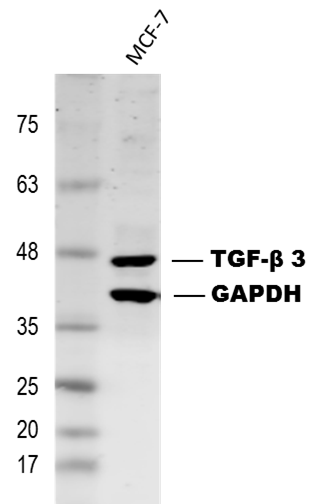| Reactivity | All-MultiSpecies Glossary |
| Applications | IHC, B/N |
| Clonality | Polyclonal |
| Host | Goat |
| Conjugate | Unconjugated |
| Concentration | LYOPH |
| Immunogen | S. frugiperda insect ovarian cell line Sf 21-derived recombinant chicken TGF‑ beta 3 Ala301-Ser412 (Tyr340Phe) Accession # P10600 |
| Specificity | Detects TGF-beta 3 in direct ELISAs. |
| Source | N/A |
| Isotype | IgG |
| Clonality | Polyclonal |
| Host | Goat |
| Gene | TGFB3 |
| Purity Statement | Antigen Affinity-purified |
| Endotoxin Note | <0.10 EU per 1 μg of the antibody by the LAL method. |
| Innovator's Reward | Test in a species/application not listed above to receive a full credit towards a future purchase. |
| Dilutions |
|
|
| Reviewed Applications |
|
|
| Publications |
|
| Storage | Use a manual defrost freezer and avoid repeated freeze-thaw cycles.
|
| Buffer | Lyophilized from a 0.2 μm filtered solution in PBS with Trehalose. *Small pack size (SP) is supplied either lyophilized or as a 0.2 µm filtered solution in PBS. |
| Preservative | No Preservative |
| Concentration | LYOPH |
| Reconstitution Instructions | Reconstitute at 0.2 mg/mL in sterile PBS. |
TGF-beta 3 (transforming growth factor beta 3) is one of three closely related mammalian members of the large TGF-beta superfamily that share a characteristic cystine knot structure (1‑7). TGF-beta 1, -2 and -3 are highly pleiotropic cytokines that are proposed to act as cellular switches that regulate processes such as immune function, proliferation and epithelial-mesenchymal transition (1‑4). Each TGF-beta isoform has some non-redundant functions; for TGF-beta 3, mice with targeted deletion show defects palatogenesis and pulmonary development (2). Human TGF-beta 3 cDNA encodes a 412 amino acid (aa) precursor that contains a 20 aa signal peptide and a 392 aa proprotein (8). A furin-like convertase processes the proprotein to generate an N-terminal 220 aa latency-associated peptide (LAP) and a C-terminal 112 aa mature TGF- beta 3 (8, 9). Disulfide-linked homodimers of LAP and TGF-beta 3 remain non-covalently associated after secretion, forming the small latent TGF-beta 3 complex (8‑10). Covalent linkage of LAP to one of three latent TGF-beta binding proteins (LTBPs) creates a large latent complex that may interact with the extracellular matrix (9, 10). TGF-beta is activated from latency by pathways that include actions of the protease plasmin, matrix metalloproteases, thrombospondin 1 and a subset of integrins (10). Mature human TGF-beta 3 shows 100%, 99% and 98% aa identity with mouse/dog/horse, rat and pig TGF-beta 3, respectively. It demonstrates cross-species activity (1). TGF-beta 3 signaling begins with high-affinity binding to a type II ser/thr kinase receptor termed TGF-beta RII. This receptor then phosphorylates and activates a second ser/thr kinase receptor, TGF-beta RI (also called activin receptor-like kinase (ALK) -5), or alternatively, ALK-1.This complex phosphorylates and activates Smad proteins that regulate transcription (3, 11, 12). Contributions of the accessory receptors betaglycan (also known as TGF-beta RIII) and endoglin, or use of Smad-independent signaling pathways, allow for disparate actions observed in response to TGF-beta in different contexts (11).
| Images | Ratings | Applications | Species | Date | Details | ||||||||||
|---|---|---|---|---|---|---|---|---|---|---|---|---|---|---|---|

Enlarge |
reviewed by:
Verified Customer |
WB | Human | 04/09/2017 |
Summary
Comments
|
Secondary Antibodies |
Isotype Controls |
The concentration calculator allows you to quickly calculate the volume, mass or concentration of your vial. Simply enter your mass, volume, or concentration values for your reagent and the calculator will determine the rest.